

6 Ways Technology Is Improving Healthcare. As technology improves every day, new developments are constantly infiltrating our lives.
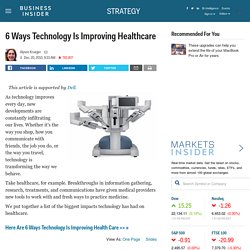
Whether it's the way you shop, how you communicate with friends, the job you do, or the way you travel, technology is transforming the way we behave. Take healthcare, for example. Breakthroughs in information gathering, research, treatments, and communications have given medical providers new tools to work with and fresh ways to practice medicine. We put together a list of the biggest impacts technology has had on healthcare. Technology improves healthcare. Fitness technology improves health of elderly. Mobile Technology Improves Health Delivery in Sauri - Videos.
Kootenai Health Improves Physician Satisfaction and Transitions of Care with Nuance Dragon Medical Solutions. BURLINGTON, Mass.
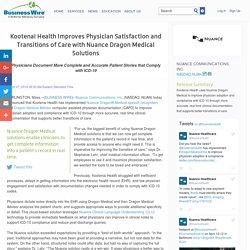
--(BUSINESS WIRE)--Nuance Communications, Inc. (NASDAQ: NUAN) today announced that Kootenai Health has implemented Nuance Dragon® Medical speech recognition and Dragon Medical Advisor computer-assisted physician documentation (CAPD) to improve physician adoption and compliance with ICD-10 through more accurate, real time clinical documentation that supports better transitions of care. Nuance Dragon Medical solutions enable clinicians to get complete information into a patient’s record in real time.Tweet this “For us, the biggest benefit of using Nuance Dragon Medical solutions is that we can now get complete information in the patient’s record in real time, and provide access to anyone who might need it.
This is imperative for improving the transition of care,” says Dr. Physicians dictate notes directly into the EHR using Dragon Medical and then Dragon Medical Advisor analyzes the patient charts, and suggests appropriate ways to provide additional specificity or detail. Health Information Technology And Patient Safety: Evidence From Panel Data. PLOS Medicine: The Effectiveness of Mobile-Health Technology-Based Health Behaviour Change or Disease Management Interventions for Health Care Consumers: A Systematic Review. Abstract Background Mobile technologies could be a powerful media for providing individual level support to health care consumers.
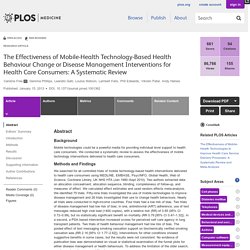
We conducted a systematic review to assess the effectiveness of mobile technology interventions delivered to health care consumers. Methods and Findings We searched for all controlled trials of mobile technology-based health interventions delivered to health care consumers using MEDLINE, EMBASE, PsycINFO, Global Health, Web of Science, Cochrane Library, UK NHS HTA (Jan 1990–Sept 2010). Conclusions Text messaging interventions increased adherence to ART and smoking cessation and should be considered for inclusion in services. Please see later in the article for the Editors' Summary Editors’ Summary Every year, millions of people die from cardiovascular diseases (diseases of the heart and circulation), chronic obstructive pulmonary disease (a long-term lung disease), lung cancer, HIV infection, and diabetes. Why Was This Study Done? What Do These Findings Mean? US6466125.pdf. Using Health Information Technology to Improve Minority Health Outcomes - Minority Nurse.
From electronic health records (EHRs) to smartphone apps, today’s health IT tools can help nurses develop innovative strategies for closing the gap of racial and ethnic health disparities.

One of the top priorities of President Obama’s Health Information Technology for Economic and Clinical Health (HITECH) Act of 2009 is to reduce health disparities—such as disproportionately high rates of chronic diseases in racial and ethnic minority populations—through the “meaningful use” of EHR technology. Seven years after the passage of HITECH, how much progress have we made toward achieving that goal? In the 2013 report Understanding the Impact of Health IT in Underserved Communities and Those with Health Disparities, the U.S. That, of course, is where nurses come in. “Nurses are coordinators of care for patients. For most nurses, health IT begins with the EHR. Technology changing landscape of heart health.
REDDING, Calif. - In 2006, Bill Townsend was at the gym on the exercise bike when he first noticed something was wrong.
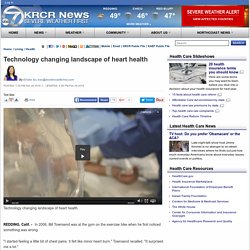
"I started feeling a little bit of chest pains. It felt like minor heart burn," Townsend recalled. Townsend went to his doctor to get checked out, only to find out that at 54-years-old, he had become a victim of the number one killer of Americans, heart disease. He had to undergo cardiac catheterization to remove the blockage in his heart. "I was in the hospital for 22 to 23 hours and the worst thing about it is that you have to lay on your back for 6 to 8 hours until where they inserted the cath finally heals up enough where you can sit up," Townsend explained. Fast-forward nearly a decade to 2015, when Townsend said he once again noticed a pain in his heart. Radial catheterization has been up and coming in the medical industry in the last decade.
"There are three major benefits to radial catheterization," Dr. Healthcare Technology Outlook 2020 - Technology uptake. Use of Technology in Health & Social Care. Emerging IoT technologies in healthcare. SearchHealthIT visited Stanley Healthcare's Experience Center in Waltham, Mass., which has simulated hospital rooms -- such as the emergency department, post-anesthesia care unit (PACU) and medical-surgical intensive care unit -- for the company to demonstrate its Internet of Things (IoT) offerings.
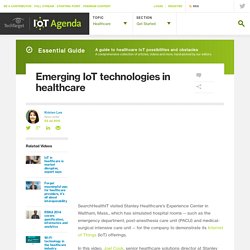
In this video, Joel Cook, senior healthcare solutions director at Stanley Healthcare, described the ways in which many of Stanley's customers use IoT in healthcare. For example, hospitals take advantage of the technology for real-time location services with badges that can track patients, staff and medical devices. "Many of our customers are using this equipment for asset management," Cook said.
Such assets include infusion pumps, wheelchairs, defibrillators, scales and other items that employees tend to tuck into out-of-sight corners yet are needed frequently for treating patients. How technology can be used in health and social care - video. Health Information Technology.